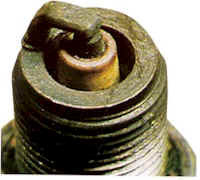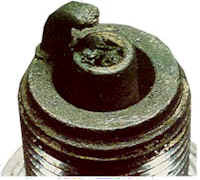|
End of Menu Items |
Spark Plug Colours and Engine Problem GuideDownload this sheet as a PDF file here.A spark plug is an electrical device that fits into the cylinder head of some internal combustion engines and ignites compressed petrol by means of an electric spark. Spark plugs have an insulated centre electrode which is connected by a heavily insulated wire to an ignition coil circuit on the outside, forming, with a grounded terminal on the base of the plug, a spark gap inside the cylinder. As the electrons flow from the coil, a voltage difference develops between the centre electrode and side electrode. No current can flow because the fuel and air in the gap is an insulator, but as the voltage rises further, it begins to change the structure of the gases between the electrodes. Once the voltage exceeds the dielectric strength of the gases, the gases become ionized. The ionized gas becomes a conductor and allow electrons to flow across the gap. Spark plugs usually require voltage in excess of 20,000 volts to 'fire' properly. Because the spark plug is inside the engine and is the only easily removable part it can be used as an indicator to the state of tune and condition of the engine. The sparkplug also says if you need to change anything in the mechanics. Below is some photos and descriptions (source Champion spark plugs) of what spark plugs can look like given certain engine conditions. I have owned many classic cars from Minis to MGs and have yet to see a spark plug in the "normal" condition, most of mine have been a combination of the normal picture and the carbon fouled around the threaded base. These pictures look like the very extreme of what can happen if problems are allowed to continue and I do not think some of the plugs would actually fire in the condition that they are shown.
Click here to return to the Technical Data page. |













